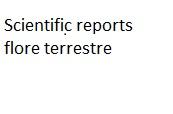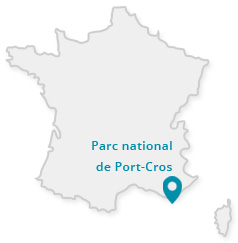
Port-Cros
Autre
Flore terrestre
L’île de Bagaud (archipel des îles d’Hyères, Var, France) a été soumise à deux
perturbations majeures d’origine anthropique au cours des derniers siècles : l’invasion du rat
noir (Rattus rattus) et des griffes de sorcière (Carpobrotus sp.). Un programme d’éradication
de ces deux taxons a été lancé en 2010 par le Parc national de Port-Cros. Ce projet prévoit
un suivi des communautés animales et végétales sur 10 ans, précédé d’un «état zéro»
pré-éradications de 2 ans. Les changements temporels des communautés végétales (i.e.,
recouvrement végétal et similarité entre la végétation autochtone et la végétation sur les
zones où Carpobrotus sp. a été retiré) ont été analysés au sein de placettes permanentes
(100 m² et 16 m²) avant (2010-2011) et après éradication (2013-2014) de Carpobrotus sp.
Le recouvrement végétal de la flore autochtone augmente considérablement à partir de
2013. En zone littorale, la reprise de la flore autochtone, comprenant des communautés halorésistantes,
semble plus rapide que dans l’intérieur de l’île, comprenant certaines espèces
de matorral bas et des espèces halo-nitrophiles. Ce suivi floristique 2010-2017 donne des
informations primordiales sur les capacités de rétablissement d’un écosystème insulaire suite
à l’éradication locale de deux taxa invasifs.
Mots-clés : biodiversité insulaire, changements temporels, espèces exotiques
envahissantes, éradication locale, suivi floristique.
Abstract. Recovery of plant communities after the eradication of iceplant (Carpobrotus
sp.) within the framework of Bagaud island ecological restoration program (Port-
Cros National Park, France): results 5 years after eradication. Bagaud island (Hyères
Island Archipelago, Var, France), was submitted to two major disturbances during the last
centuries: the invasions of the black rat (Rattus rattus) and iceplant (Carpobrotus sp.). An
eradication program of these two taxa was launched in 2010 by the Port-Cros National Park.
This project involves a 10-year monitoring of animal and plant communities, including a preeradication
monitoring in 2010 and 2011. Temporal changes of plant communities (i.e., plant
cover and similarity between native vegetation and vegetation in areas where Carpobrotus
sp. was removed) were analyzed in permanent plots (100 m² and 16 m²) before (2010-2011)
and after (2013-2014) Carpobrotus sp. eradication. Native plant cover significantly increased
since 2013. On coastal sites, the recovery of native flora is fast and matches with the haloresistant
reference plant community. On the other hand, on inland sites, the recovered native
flora includes some low matorral species as well as halo-nitrophilous species. This monitoring
from 2010 to 2017 is important to understand plant community recovery after the eradication
of 2 invasive taxa.
Keywords: invasive species, island biodiversity, local eradication, plant community
monitoring, temporal changes.
| Auteurs | Elise BUISSON, Annie ABOUCAYA, Laurence AFFRE, Julie BRASCHI, Julie CHENOT, Sébastien DAILLY, Manon HESS, Aurélie PASSETTI, Daniel PAVON, Hervé RAMONE, Christel VIDALLER, Elise KREBS-AMY |
|---|---|
| Éditeur | Parc national de Port-Cros |
| Nombre de pages | 12 |
| Référence | Sci. Rep. Port-Cros natl. Park, 32: 123-135 (2018) |


